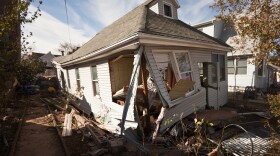One year ago, Hurricane Sandy devastated the Eastern Seaboard with high winds, heavy rain and a storm surge of more than 13 feet, claiming 44 lives and displacing thousands. The Superstorm turned the greatest city in the world into a city of darkness and called new attention to climate change.
October 29, 2012 began with ominous warnings for the East Coast. At 8 a.m., the National Hurricane Center reported tropical-storm-force winds along the coasts of southern New Jersey, Delaware and eastern Virginia. No one knew the exact track Sandy would take, but they understood it wouldn't be good.
Entergy Vermont Yankee Spokesman Rob Williams told WAMC how the Vermont Yankee Nuclear Power Plant was shoring up for the storm. In Massachusetts, Secretary of Energy and Environmental Affairs Rick Sullivan said the commonwealth was bracing for the worst. Preparations were also underway up and down the Hudson Valley, still smarting from Hurricane Irene and Tropical Storm Lee. Ulster County Executive Mike Hein appeared on WAMC's Roundtable.
As the day progressed, all eyes and ears were on the approaching hurricane. Gusts of about 70 mph had already been recorded in southern New Jersey when, at 7:42 p.m., Consolidated Edison shut down power to a large part of Lower Manhattan as a precaution, in hopes that the electricity could be restored more quickly after the storm passed.
8:43 p.m. ET. Sandy made landfall along the New Jersey coastline, and more than 1 million lost power across the Northeast. The storm surge flooded New York Citystreets, tunnels and subway lines. NYU Hospital lost power and its backup generator failed. Dozens of homes were destroyed in a massive fire in the Breezy Point section of the Rockaways.
University at Albany’s Chris Thorncroft, chair of the department of atmospheric and environmental sciences, spoke the day after Sandy hit. Hurricane Sandy went down in the books as the second-costliest Atlantic hurricane on record. The National Climatic Data Center estimated the cost of Sandy at $65 billion, following Hurricane Katrina on the list of costliest disasters ever to hit the United States. The federal governmentto date has sent more than 14 billion dollars inassistance to New York and New Jersey alone. Many suggested that global warming played a role in the intensity of the cyclone, but researchers were unable to say just how responsible climate change was for the development and track of Sandy.
New York Governor Andrew Cuomo obviously had reached a personal tipping point. Climatologist Jessica Reynolds with the Northeast Regional Climate Center at Cornell says there really is a "new normal."
The recovery, relief and rebuilding efforts in the days weeks and months that followed were massive. WAMC joined the relief effort to assist victims of Superstorm Sandy, raising more than 240-thousand dollars during a special one-day fund drive last November 8th.
New York State Comptroller Tom DiNapoli says Tuesday his office continues to process contracts for infrastructure repairs, debris removal and beach restorations, even as challenges remain.











